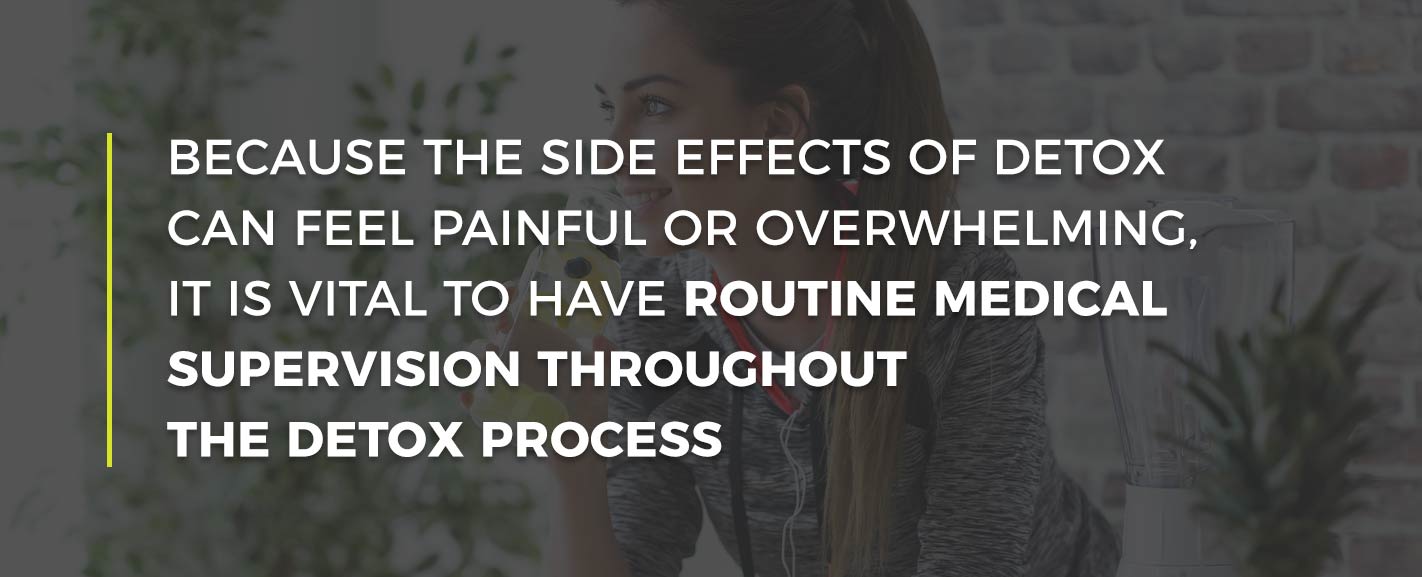- Jan 19
- Drug DetoxRecovery
Detox and withdrawal are two of the most commonly used words regarding the struggles of quitting a substance. Although detox and withdrawal may be related, the terms cannot be used interchangeably. Understanding the difference between detox and withdrawal can make overcoming substance use disorder less intimidating and more manageable.
The sections below will review the differences between drug and alcohol detox and withdrawal and the best practices for addressing substance abuse.
Detox
Before diving into the differences between detox and withdrawal, you need to understand the basics of detoxification. Below, you’ll learn what detox is, what it looks like and a general detox timeline.
What Is Detox?
Detoxification refers to the process of the body and mind releasing the addictive chemicals they have stored up during substance use. When used in high quantities for an extended period, drugs like heroin, opioids and alcohol can alter your physiological functions and interfere with your cognitive abilities, making your body reliant on the substance. For this reason, the body responds intensely and quickly whenever a person quits using drugs.
Because quitting drugs can come with some adverse side effects, having medical supervision during detoxification is key. Attempting to detox without any professional assistance can be extremely dangerous. Fortunately, there are options when it comes to detoxification programs.
In general, these are the three types of drug detox programs to choose from:
- Inpatient detox: Staying at an inpatient facility is the safest way to go through detox because it ensures professional help is always nearby. The constant supervision of medical professionals creates a safe environment for going through potential withdrawal symptoms.
- Outpatient detox: An outpatient detox program poses a slightly higher risk of relapse or complications than an inpatient program. However, an outpatient program allows patients to remain at home with their families while still receiving regular supervision from a medical professional.
- Medical detox: A medical detox program involves using medications to ease some of the physical and mental symptoms associated with withdrawal. This method mitigates the impact of withdrawal, making it easier to quit a substance without relapsing. As the detox winds down, the medication is gradually stopped. Medical detox can be used in either an inpatient or an outpatient setting.
What Does Detox Look Like?
Detoxification can be an intense process, with many of the symptoms commonly associated with drug withdrawal. The exact side effects of detox vary depending on a patient’s body chemistry, along with the type of drug they used and the length of time their addiction has been going on.
However, the most common symptoms of detoxification include:
- Nausea
- Fatigue
- Anxiety
- Irritability
- Insomnia
- Fever
- Rapid heartbeat
- Sweating
- Muscle pain
- Seizures
- Hallucinations
Because the side effects of detox can feel painful or overwhelming, it is vital to have routine medical supervision throughout the detox process. Eventually, these symptoms will subside as the body learns to regulate itself without the substance in its system.

What Is the Typical Detox Timeline?
Detoxification is a process that looks different for everyone. However, the process generally follows the same patterns and cycles, making it easier to tell patients what to expect during their program. Below is a rough timeline of the detoxification process:
- First 12 hours: Initially, detox symptoms are mild but quickly begin to worsen. The patient may start to experience nausea, shaking, headaches, anxiety and irritability.
- First day: Symptoms become increasingly severe and may include disorientation, tremors and seizures.
- Second day: The second day will be similar to the first and involve some of the most painful symptoms. Panic attacks and hallucinations are common at this point in the process.
- The rest of the first week: Different symptoms may come and go throughout the rest of the first week. Now is when the most serious symptoms typically take place. A medical detox program can often help prevent further health complications and provide some pain relief.
- After one week: Once the first week of detox is over, most symptoms will start to taper off. Although some symptoms may linger, they will likely be far less severe and treatable with medication.
- The rest of detox: After the first week or two of a detox program, the worse withdrawal symptoms should be done. However, patients will still be healing both physically and emotionally and should stay in a safe, supportive environment. On rare occasions, patients will experience continued symptoms in a condition known as post-acute withdrawal syndrome. In these cases, medications can be prescribed to manage the side effects.
Withdrawal
Knowing the details of withdrawal is key to understanding why detox programs are so important. This section will go over what withdrawal is and what it looks like.
What Is Withdrawal?
Withdrawal is a wide range of symptoms that those with a substance use disorder experience when they suddenly stop using. Because drugs and alcohol impair certain brain functions by interfering with the connections between neurons, the brain gradually builds a tolerance for the substance. Eventually, the person feels as if they have to drink or use more to get through a day.
When the person quits drinking or using, the sudden absence of the substance shocks their nervous system, causing withdrawal symptoms. These withdrawal symptoms can range from fairly mild to life-threatening. The severity and danger of withdrawal symptoms make withdrawal a major obstacle to overcoming a substance use disorder.
What Does Withdrawal Look Like?
Withdrawal symptoms typically start within hours of when a person stops using drugs or alcohol and reach their peak intensity within a few days. Usually, withdrawal symptoms last for about a week before declining. Below is an overview of what withdrawal commonly involves:
- Day one: Withdrawal often starts with nausea, irritability and sweating. A person’s blood pressure may rise, and they may experience an accelerated heartbeat, tremors and insomnia.
- Day two: Withdrawal symptoms worsen the second day and, in severe cases, may include seizures and hallucinations.
- Day three to five: The next few days of withdrawal usually involve acute emotional distress, and hallucinations or tremors may continue.
- Day seven: After about five days, the physical symptoms of withdrawal start to subside. However, the psychological symptoms, such as irritability, anxiety and insomnia, usually persist for weeks or even months.
What Is the Difference Between Detox and Withdrawal?
When it comes to drug and alcohol detox vs. withdrawal, the essential difference is having a treatment program. Although detoxification involves going through withdrawal, it includes providing patients with the medical supervision, assistance and support they need to overcome withdrawal. A detox program involves handling withdrawal and caring for the body until the drug is completely out of the system and withdrawal is finished.
Because detox and withdrawal can be dangerous, they should not be attempted at home. In particular, trying to detox from opiates and alcohol alone can have fatal results. The best practice is to seek detox within a safe, professional environment with professionals that monitor withdrawal symptoms and care for patients.
Let Gateway Foundation Assist Walk You Through the Detox Process
Now that you know what the difference between withdrawal and detoxification is, you might be ready to start a detox program. If you’re looking for a reliable, caring treatment facility, visit Gateway Foundation. At Gateway Foundation, we provide high-quality treatment that produces long-term results.
We offer programs and services that address both the physical and emotional effects of substance use disorder. Our team of medical professionals can prescribe medications to help minimize withdrawal symptoms, while our therapists can help patients manage any emotional distress or co-occurring mental disorders. When you choose recovery at Gateway Foundation, we are with you for life.
For more information about the detox program options available to you, contact Gateway Foundation today.


